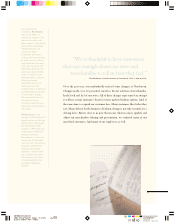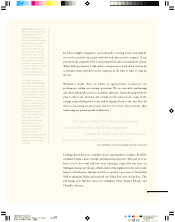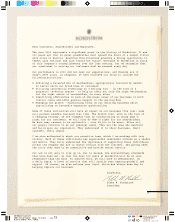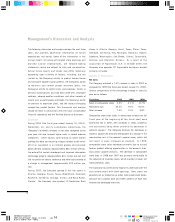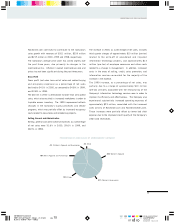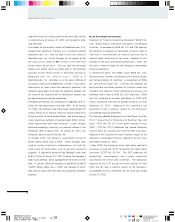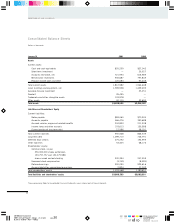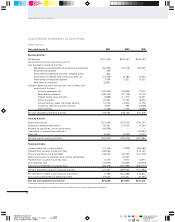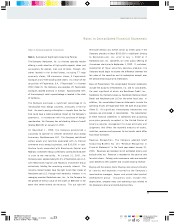Nordstrom 2000 Annual Report Download - page 16
Download and view the complete annual report
Please find page 16 of the 2000 Nordstrom annual report below. You can navigate through the pages in the report by either clicking on the pages listed below, or by using the keyword search tool below to find specific information within the annual report.
Cyan Mag Yelo Blk
20100444 Nordstrom
2001 Annual Report • 44pgs. + 4 covers pg. 14
8.375 x 10.875 • PDF • 150 lpi
PMS
5773
PMS
5503
14
Management’s Discussion and Analysis
The following discussion and analysis reviews the past three
years and provides additional information on future
expectations and trends. Some of the information in this
annual report, including anticipated store openings and
planned capital expenditures, are forward-looking
statements, which are subject to risks and uncertainties.
Actual future results and trends may differ materially
depending upon a variety of factors, including, but not
limited to, the Company’s ability to predict fashion trends
and consumer apparel buying patterns, the Company’s ability
to maintain and control proper inventory levels, the
Company’s ability to control costs and expenses, trends in
personal bankruptcies and bad debt write-offs, employee
relations, adverse weather conditions and other hazards of
nature such as earthquakes and floods, the Company’s ability
to continue its expansion plans, and the impact of ongoing
competitive market factors. This discussion and analysis
should be read in conjunction with the basic consolidated
financial statements and the Ten-Year Statistical Summary.
Overview
During 2000 (the fiscal year ended January 31, 2001),
Nordstrom, Inc. and its subsidiaries (collectively, the
"Company") achieved increases in net sales compared to the
prior year, but also incurred higher costs in several expense
categories. Other factors contributing to lower overall
profitability were non-recurring charges related to the write-
off of an investment in an Internet grocery and consumer
goods delivery company (approximately $33 million pre-tax),
the write-off of certain abandoned and impaired information
technology projects (approximately $10 million pre-tax) and
the incurrence of certain severance and other costs related to
a change in management (approximately $13 million pre-
tax).
During 2000, the Company opened 6 full-line stores in
Atlanta, Georgia; Frisco, Texas; Broomfield, Colorado;
Roseville, California; Chicago, Illinois; and Boca Raton,
Florida. The Company also opened 10 Nordstrom Rack
stores in Atlanta, Georgia; Hurst, Texas; Plano, Texas;
Glendale, California; Troy, Michigan; Honolulu, Hawaii;
Spokane, Washington; Oak Brook, Illinois; Scottsdale,
Arizona; and Chandler, Arizona. As a result of the
acquisition of Façonnable, S.A. in October 2000, the
Company also operates 20 Façonnable boutiques located
primarily in Europe.
Results of Operations
Net Sales
The Company achieved a 7.4% increase in sales in 2000 as
compared to 1999 (the fiscal year ended January 31, 2000).
Certain components of the percentage change in sales by
year are as follows:
Fiscal Year 2000 1999 1998
Sales in comparable stores 0.3% (1.1%) (2.7%)
Nordstrom.com 32.2% 9.2% 35.5%
Total increase 7.4% 2.0% 3.8%
Comparable store sales (sales in stores open at least one full
fiscal year at the beginning of the fiscal year) were
essentially flat in 2000, with increases in shoes, cosmetics
and accessories being offset primarily by decreases in
women’s apparel. The Company believes the decreases in
women’s apparel are primarily attributable to a change in the
merchandise mix in the women’s apparel areas, which did
not result in sales increases as planned. In 1999,
comparable store sales decreased primarily due to missed
fashion product offering opportunities in the women’s, kids’
and juniors’ apparel divisions. The decrease in comparable
store sales in 1998 over 1997 was primarily attributable to
the reduction of inventory levels, which resulted in lower, but
more profitable, sales.
The Company has continued to expand its store base over the
past several years with store openings. New stores are
generally not as productive as older, more established stores,
because the customer base and traffic patterns of each new
location are developed over time.



